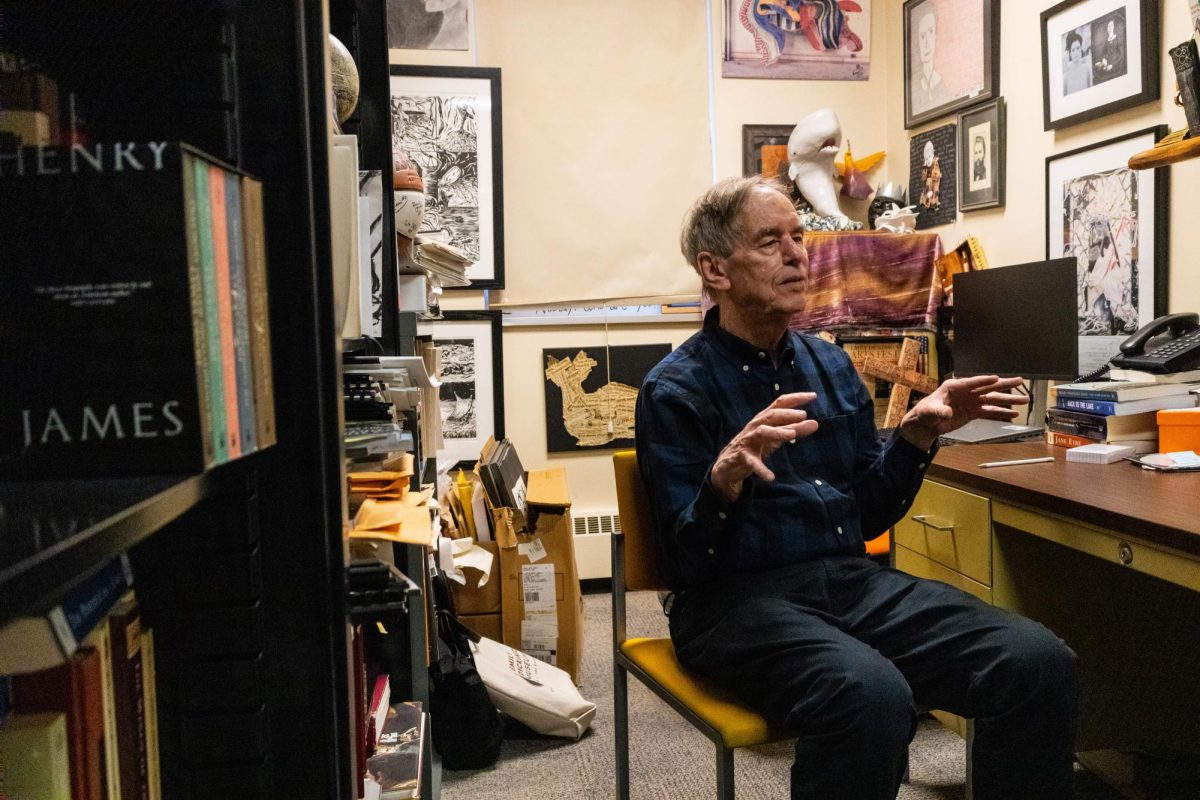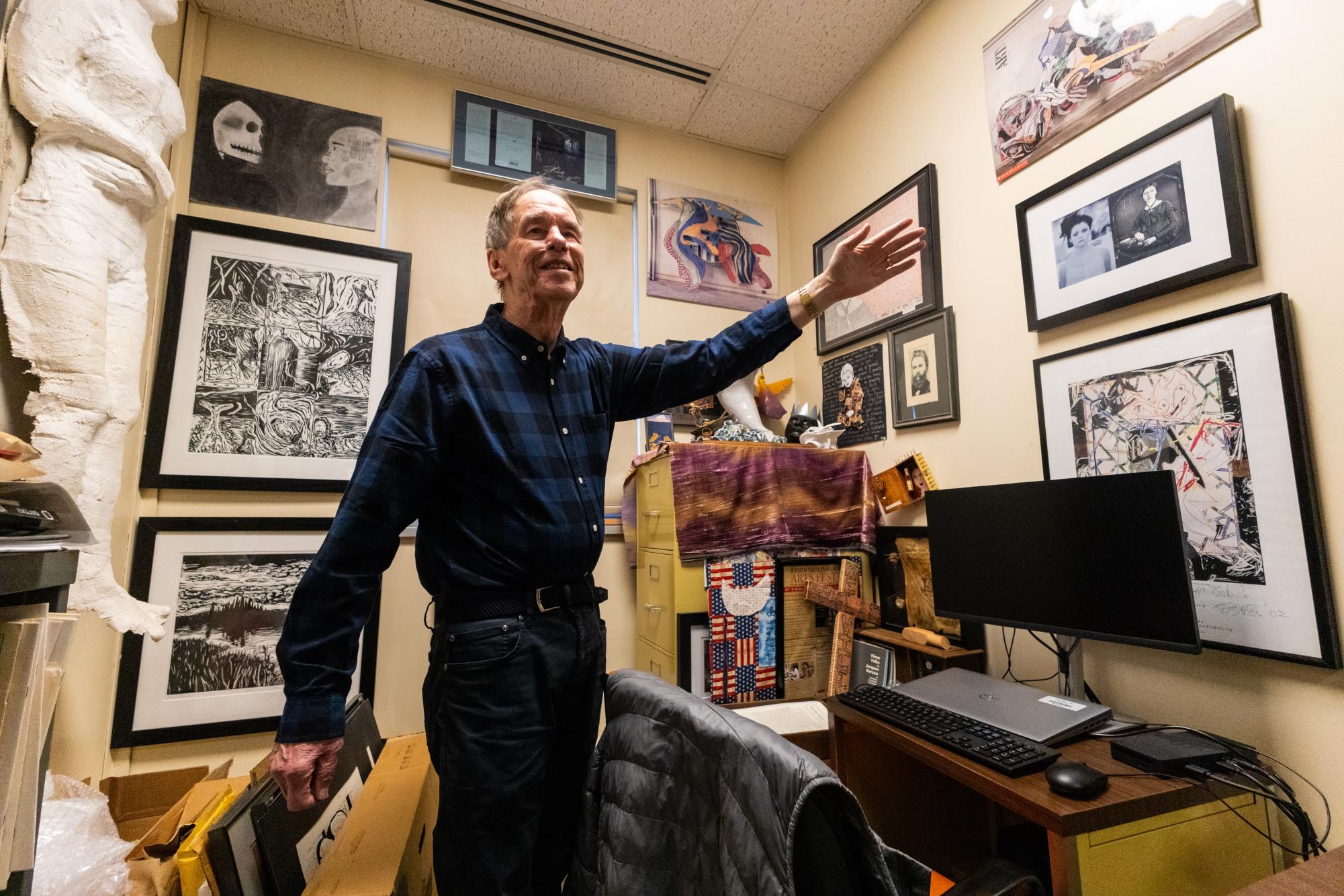Robert Wallace disagreed with his father on three things. One on career choice. Another on war.
His father fought in the Pacific Theater during World War II as a Navy lieutenant commander in a submarine chaser. He wanted Wallace to join the Navy Corps like he had done before, just as the Vietnam War was looming. But Wallace refused that war, and instead received a deferment to attend graduate school—besides, his eyesight was not good enough for the Navy. When his father learned of his decision to double major in law and English, he was upset.
“He was a can-do kind of guy,” Wallace said. “He didn’t read novels or anything, so he didn’t really understand the attraction of literature to me.”
At 79 years old, regents professor Dr. Wallace is best known as a pioneer in synthesizing literature with visual art in two classes, “Moby-Dick and the Arts,” a spring semester staple since 1994, and “Emily Dickinson and the Arts.” Both classes have resulted in exhibitions and printed catalogs.
Gray-haired in his black-and-dark-blue plaid shirt, mottles dotting his wrinkled skin, he sits in an office that occupies a hallway’s end in the Landrum Academic Center, marked conspicuous by a plaque of the titular white whale over its doorframe. The door faces a row of stuffed bookshelves, next to a full-body plaster cast representing the “Moby-Dick” harpooner Queequeg and composite woodcut panels. A porcelain statue of Moby-Dick towering over Captain Ahab, harpoon-armed, perches beside his bright orange desk.
Wallace counted among the first crop of students at what was then a community college in Northern Kentucky, an institution so new and so small that all classes concentrated in one concrete building surrounded by farmlands and rolling hills. He has stuck around at what is now Northern Kentucky University for 50 years.
Wallace did not choose NKU, not initially. The job market chose him. He originally applied to the nation’s top law schools—Harvard, Yale, Columbia—as well as the graduate English programs at Columbia and Claremont in California. He accepted Harvard’s offer two weeks before the deadline, then chased after the mail carrier to retrieve his letter so he could go into English instead. He wrote to 90 different schools on the East Coast, he recounted—only Northern Kentucky Community College responded with an interview.
Before he joined ranks with NKU’s first class of roughly 70 anti-war, pro-civil rights graduate students, in 1968 Wallace contemplated disserting on Herman Melville’s “Moby-Dick.”
“They told me I couldn’t do my dissertation on [“Moby-Dick”] because everything has been said,” Wallace said, chuckling. All of the works adorning his office, spanning a range of artistic media, have sprung from the imagination of Wallace’s students and their unique interpretations of “Moby-Dick.” Yet before Melville and the paintings, the sculptures and poetry and collage art, he designed, proposed and taught a course on the parallels between Mozart’s ninth concerto and Jane Austen’s “Pride and Prejudice.”
“At first my essays were not accepted because it wasn’t a form of English literary studies,” Wallace recalled. His reasoning was considered analogies, looked down upon as weak and subjective and hard to prove. The prevailing thought among academics at the time focused on the obvious: art songs or literature set to music, opera librettos, concrete poetry. Nonetheless, Wallace’s students finally convinced him to pursue that untrodden path.
Wallace taught the course for three years. One of his students, Barbara Flanagan, asked if he could replicate the course concept but with painting, and she lent a hand in building what would become “Melville and the Arts.” Just as studying the hidden correspondence between music and literature enmeshed Wallace in classical music, the course development immersed him this time in visual arts.
In the spring of 1994, art major Fred North requested to submit a painting instead of the usual research paper on the relationship between Melville and the arts. He eventually produced two paintings inspired by “The Lee Shore” chapter, which—together with Elizabeth Schultz’s course-required book “Unpainted to the Last”—metamorphosed the class into “Moby-Dick and the Arts.”
Given the choice between a research paper or an artwork for their final project, more and more students have chosen art, to offer their artistic reinterpretations of a novel that has been interpreted in every way possible. By spring of 2015 the class had accumulated enough works for an art exhibition, which one of the students, art history and honors alumna Emma Thompson, helped organize for her BFA Senior Show. She built a little model of an art gallery as her final project, then with help from local printshops curated student-produced artworks for the 2015 “Moby Comes to Covington” exhibition at the Kenton County Public Library’s Covington branch.

So, why Melville? Herman Melville, in Wallace’s description, held profound respect for the diverse peoples and cultures of the world. He embedded himself in indigenous communities and produced works that, implicitly or explicitly, condemned the colonialist and imperialist European-American powers encroaching upon their lifeways. The multiethnic, multicultural cast in “Moby-Dick” have thus come into new resonance with today’s readers.
Kathleen Piercefield enrolled in NKU’s Bachelor of Fine Arts program at the age of 49, after 30 years as a stay-at-home mother of four. When she took “Moby-Dick and the Arts” in the spring of 2004, she found a spark of inspiration in Melville’s visual understanding: the marks of barnacles and scarring on the skin of whales, a language that reveals the creature’s history if one knows how to read it. The same concept is embodied in Queequeg, covered from head to toe in tattoos or, in the author’s words, a history of life, death and the universe. She embarked on her own quest to learn and incorporate mark-making into her art. Her “Moby-Dick”-inspired works included two etchings, a map charting the Pequod’s voyage in search of the white whale and, for her senior thesis show, a larger-than-life full-body portrait of Queequeg with all of his tattoos.
Wallace’s impact on her art and career extend beyond the Landrum classroom. He repeatedly encourages his students to keep in touch, and his connections have directed Piercefield toward eight different exhibitions across the country, from Penn State to Rhode Island to Illinois, including her most recent one at the New Bedford Whaling Museum in Massachusetts.
“Knowing him broadened my experience greatly, and probably all of his other students will say the same,” Piercefield said.
Wallace and his wife Joan Ferrante—a NKU sociology professor, also founder and director of the “Mourning the Creation of Racial Categories” project—have an inexplicable knack for landing students jobs. Once upon a semester Ferrante needed help editing her textbook, for which she contacted Emma Thompson. One of the women Ferrante had interviewed for the book ran the department where Thompson now works at RSW/US, a marketing company for marketing companies.
Onyinye Uwolloh also got where she is now thanks to Wallace and Ferrante. She earned her psychology undergraduate degree in 2020, her master’s in industrial/organizational psychology in May this year, and is now working as an assessment and curriculum analyst for NKU’s Undergraduate Academic Affairs. For the spring 2018 “Moby-Dick and the Arts” class, she composed 136 haiku for each chapter of the novel in Pidgin English, one of the 500 plus languages spoken in her home country Nigeria.
“No one in the class was an art major. I didn’t know anything about art and Dr. Wallace was like, ‘Here are all my students who’ve done art in my class over the years. This person went on to an art gallery…’” Uwolloh recalled. “Okay, he seems to believe in us so we should believe in ourselves! He has this way of making you believe in yourself for things you never considered before.”
Throughout nearly six years of collaboration, Wallace has accompanied Uwolloh to many events, written recommendation letters for her and introduced her to faculty members.
“If he sees any potential in you, he’ll do anything he can to help you nurture that and grow,” Thompson said. “You could mention one thing and two years later he’ll remember it.”
“Having Bob Wallace for a class was a wonderful academic experience, but then it developed into a lasting friendship, and I will always value that friendship,” said Piercefield, who continues her work today as a print artist with Cincinnati’s Tiger Lily Press.
For English professor Dr. Kristine Yohe, her friendship with Wallace began in 1997 when she arrived at NKU for a job interview. Wallace sat on the search committee that eventually hired her, and they immediately hit it off over their mutual love for American literature, diverse voices in literature and history. “And so right away, we were kindred spirits,” she said. His innovative methods have inspired her to incorporate visual engagement into her own literature courses.
Yohe and Wallace both participated in the Institute for Freedom Studies, an organization founded in 2001 by former sociology professor Prince Brown as the National Underground Railroad Freedom Center in Cincinnati was undergoing construction. During 10 years of activity, the 12-member team convinced NKU departments to hire more minority faculty, hosted art competitions, organized bus tours and Underground Railroad conferences for national and international scholars, and helped students discover the history of anti-slavery activism in Greater Cincinnati-Northern Kentucky.
Wallace has led a long life of social justice activism. He ran for and got elected student body president at Whitman College in the 1960s, specifically to challenge what he calls the “White Christian clause” that barred students who were not white or Christian from joining Greek life. He spearheaded a campaign to send 2,300 letters to higher educational institutions across the country calling for similar changes. The 1965-66 campaign did not succeed, but by 1968 an undercurrent of change was roiling on campuses everywhere.
He is not personally involved in ecological and climate activism, though he greatly admires those who are—and he contributes to the conversation by teaching about the ecological message in “Moby-Dick.” He also recognizes that great change requires patience. It took 20 years before the wider American culture realized the injustice and inhumanity of the Vietnam War, and farther back, Frederick Douglass was advocating for the nationwide abolition of slavery at a time when the most forward-thinking politicians only wanted the North slavery-free.
This is why he remains optimistic about the future.
“It takes a while for a really major movement to succeed, and of course we’re on a timeclock as far as ecology goes,” Wallace said, adding that success also demands a degree of risk. “I’m hopeful, but it takes the dedication of people to get out there and take chances of being arrested. You’ve got to put yourself on the line.”
Looking back, Wallace is happy with every choice he has made. He has fully embraced his position as a teacher of literature and art, which he said keeps him learning new things all the time. And his students might agree.
“All of his classes were more like a conversation. I feel like he was learning as much from us as we were from him,” Emma Thompson said.
Wallace is at retirement age, but he would rather continue teaching and researching than retire—unless his faculties become too weathered by age. He still has many projects in the works, like a book on Frederick Douglass and Cincinnati anti-slavery, which he has put on hold for the Melville’s Print Collection: 420 paintings collected by Melville for which Wallace has started writing essays, with the goal of digitizing them as an online catalog. With the help of two NKU students, he has finished uploading 203 entries since he first discovered the collection, 90 years after Melville’s death.
“I want to get this done before I die,” he remarked.



